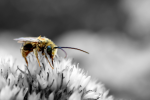The Benefits of Beekeeping in Crafting a Sustainable, Flourishing Garden
Thanks to Ali Taylor for this article. I don’t usually use guest posts but this is such an important subject that I accepted her offer.
At least 30% of the world’s crops and 90% of all plants require cross-pollination to spread and thrive, making bees a crucial component of crafting a flourishing garden in a way that doesn’t harm the environment. Whether you want to incorporate more beautiful flowers into your garden or love being able to have a positive impact on the environment, beekeeping is becoming more and more popular as a sustainable hobby. And, the great news is that it’s not at all hard to get started and involved in backyard beekeeping.
The Sustainability of Bees
Before engaging in beekeeping, it helps to understand just how this practice will be having a positive impact on the environment as well as your garden space. While there are many other types of pollinators that exist in nature, bees are particularly helpful in pollinating plants, crops and flowers that we depend on. In fact, three out of four crops across the globe that produce fruits or seeds as food depend, at least in part, on pollinators such as bees. As well, by focusing on pollination management in your garden, studies have shown that crop yields could be increased by about 25%, meaning that your garden can grow faster and healthier. As your garden begins to thrive and flowers begin to flourish, you are also creating a positive impact on the air quality in your local community as these types of flowers have been shown to reduce air pollution.
Utilizing Beekeeping as a Gardening Technique
While helping the ecosystem is great, there are also benefits on the simple beauty of your garden as well. Encouraging bees to live in your garden by giving them a safe home and honey bee hive will help increase pollination and not only allow you to grow more flowers, but allow the already existing flowers to truly thrive. This is due to the fact that pollen is full of fat and protein, which helps feed the hives that will call your garden home. When your bees collect this pollen, they carry it from one flower to another, and this type of cross-pollination is essential for flowers in order to produce more seeds. As your bees grow and continue to cross-pollinate, more flowers and plants will grow, making for a beautifully lush garden that can help your local air quality and make your yard look great.
Crafting a Bee-Friendly Space
Assuming you’re up-to-date on how to get started and what you’ll need to cultivate healthy beehives, you will also want to consider how to create a bee-friendly space outside of the hives. You will want to plant wildflowers, sunflowers, milkweed, elderberry, lavender, blooming trees and shrubs in order for your bees to have a steady supply of nectar and pollen from early spring to fall. You can also fill a birdbath or other shallow dish with gravel to ensure the bees can drink water without drowning. Provide a lot of material such as stems and sandy soil for nesting and look out for bees such as mason bees, blueberry bees, squash bees and bumblebees. These are the best for pollinating these types of plants and will ensure your garden is thriving all year long.
The Buzz on Beekeeping
While a variety of ways exist to engage in a sustainable lifestyle, beekeeping is one that benefits both you and the environment. Ensuring your garden is optimized to welcome or house bees is a great way to participate in a sustainable activity while also learning more about the Earth’s ecosystem and how these little insects weave their way in and out of it. You’ll find that your garden looks healthier than ever, and you’ll likely be ensuring that your city’s local ecosystem is healthy and clean as well.

